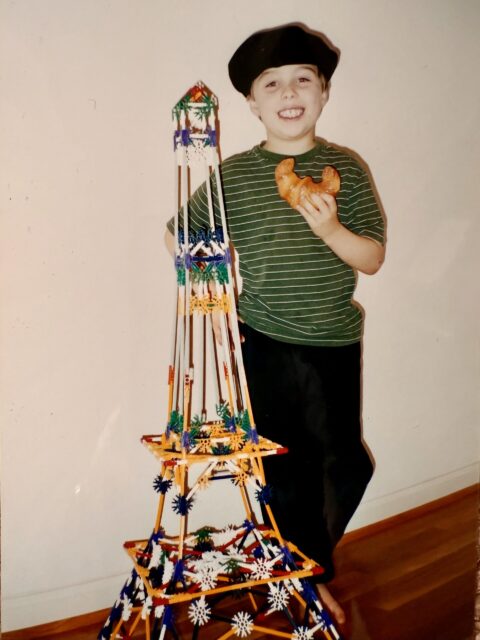The plastic croissant kills me.
Dear fellow wonderer,
Are you as fed up as I am hearing about how kids today have been irreversibly damaged? That they do nothing but gaze brainlessly as screens? Let’s flip that script, shall we? Let’s talk about kids who are playing and making and messing around and acting like actual kids.
My kids are grown, so I delight in hearing stories about kids like writer/artist Austin Kleon’s, who make music and art and an animation you can see at the bottom of this post. (Austin’s upcoming book is about how his kids inspire him and I can’t wait.) Like the kids of The Creative Shift‘s Dan Blank, featured in his newsletter’s “Kid of the Week” section, doing kid-stuff like typing and playing with Lincoln Logs and boxes. Like the 14-year-old student of my friend Meliss, who spends his free time sewing and blinging up his hoodies with studs. Like Edan Lepucki’s kids: I linked this last week, but if you didn’t read, please go check out their shenanigans devising trading posts and writing sitcoms and dreaming of jetpacks.
I want to hear about more kids like this. We need to hear about more kids like this.
* * *
There’s a lot kids these days are up against, I know. Three decades ago, childhood free time began to dissipate. Between 1981 and 2003 American kids lost 9 hours of free time a week–more than a school day. (Makes you wonder how that might connect with how kids’ creativity began its relentless decline, starting in 1990.) Those free time losses continued–though it’s hard to find current stats. If you know some, help a writer out!
There are multiple, complex reasons, which we’ll dig into in future letters: fears over kids’ safety; economic shifts; the amping-up of the college application process; the rise of parenting “experts”; changes in education; and the shift toward “intensive parenting”–which is knotted up and complicated by everything previous on this list.
And then, yes, the ever-intensifying lure of screens. The American Academy of Child and Adolescent Psychiatry says that kids 8-12 now spend an average of 4-6 hours a day watching screens. For teens, it’s nine hours.
But that’s an average. It’s not what all kids are doing. Some are making animations and playing inside boxes and studding up their hoodies and show-running sitcoms.
* * *
Probably one of the most important lessons in my life–the lesson that compels my mind, my writing here, the book I’m working on–is how much I learned from my kids about the value of their play and their self-initiated projects.
Understand that my kids had to teach me. Yes, as a former elementary school teacher who had taken a lot of developmental psych classes, I understood that play was important. But I didn’t really get it. That work took years.
Something shifted, though, when my oldest turned five and we officially started to homeschool. I was responsible for his education! I began to pay close attention to when and how he learned. What I noted: when he was playing or pursuing something that really interested him, he was more engaged. (Go figure!) His learning was palpable.
His little sister along for the ride, there were rock museums, and trading card stores, and furniture for small stuffed mice, and many maps and diagrams, and forts, and a paper-bag costume for a pizza delivery guy, and Ed Emberly sketches, and Peter Pan-inspired flying off couches, and endless hours of building with Legos while listening to audiobooks (which, to be historically accurate to those late ’90s times, we called story tapes.)
Hot parenting tip!!! Homeschooling meant we spent whole days together. Playtime for the kids meant time to myself. [insert jackpot sound.]
I said the work took years. This was just the beginning.
* * *
You can find books and hot takes and news stories everywhere about the detrimental effects of screen time for kids. (Not linking. You know.) You simply don’t see a fraction of that coverage on the downside of diminishing play and free time.
We no longer value play in our culture. Or maybe we never really did value play, but it was accepted as a defining aspect of childhood.
Playing was simply what kids did.
* * *
Shifting norms have made parents believe that they should be doing more for their kids. Preparing them for college acceptance, future success.
These norms have convinced parents to enroll their kids in more structured after-school and summer activities, especially sports. These norms have convinced parents that they should be interacting more with their kids.
I’m sure you’ve heard the stat: employed mothers today spend more time engaged with their kids than mothers did in the 1960s, when the majority of mothers did not work outside the home. And almost a quarter of those nowadays mothers still feel that they aren’t spending enough time with their kids.
In today’s parenting culture, leaving fallow time in kids’ schedules and leaving those kids alone to entertain themselves sounds positively neglectful. But what if kids need that time to play and pursue their own interests?
* * *
It was easy enough to allow time for my kids’ play when they were little. But as they got older, I worried about letting them center their time on their interests. Would they have the skills they needed to be successful, whatever that meant? But years of watching their engaged antics had gotten through my thick skull so we carried on.
They made books, and rock bands, and birthday cards, and movies–so many movies–and tiny Indian kitchens, and trebuchets, and wheels-of-fortune, and ultimate guides and Halloween costumes; and they busked, and danced, and emceed; they wrote scripts, and epic tales in dactylic hectameter, and slightly-trolly though also hilarious and mostly kind comments on random people’s YouTube videos.
And fake blogs. My daughter and her friend once wrote a fake blog based on characters they’d been playing in a movie they’d been filming for two years. No, wait! The blog was written by the fake actresses who played the characters in said movie. Since the actresses were stars, money was no object. They had purebred dogs–researched online, of course–and one actress had, I believe, an emu. Also, the actresses were taking a trip around the world. L. and her friend mapped out the trip, researching real flights and their departure times, searching for the ritziest hotel possible in Madrid and “quaint little beach villages” on the western coast of Ireland. I remember L. insisting that I come to the computer real quick to check out her suite at the beach resort where they’d be staying on the French Riviera.
And then they blogged about it. Until they got bored and moved on to something else.
* * *
How do you allow kids time for such silliness when all the other parents seem to be maximizing their kids’ time, amplifying their days for future college application essays?
But sometimes kids’ play leads directly to what they do next in life. My oldest spent a lot of his early teen years making ridiculous movies with his siblings and friends, and went on to a career in cinematography and making visual content. Check out his younger brother at seven in part two of that ridiculous movie–ordering a martini shaken-not-stirred at the Palace Hotel–and maybe you’ll understand why he’s a few months away from college graduation with a double major in History and Comedy Filmmaking.
Maybe there’s less of a direct connection between the girl who wrote fake blogs about resorts on the French Riviera and the young woman who works in urban policy and community development in New York City–but then again, maybe not?
Although direct connections are really not the goal or the point. Research tells us that play and self-directed activities help kids develop executive functioning skills, well-being, and independence.
But we don’t really need research to tell us that, do we?
* * *
Maybe this is what matters most: kids who are engaged and excited about their own ideas in the moment, on a day to day basis, are bound to know what they like to do, to know themselves.
In her piece about her kids’ play, Lepucki jokes (half-jokes?), Can you put day dreaming on your college application? I’ve helped dozens of kids on college application essays, and I’d say: Yes! Go for the daydreaming essay! Might be a standout these days…
The kids I’ve shepherded through the application essay process have been unique. Many were homeschoolers–my kids, kids from our community–and many others were students from an inspiring internship-based public high school here in Oakland. All kids who had atypical amounts of time to pursue their own quirky interests, both inside classrooms and outside of them. Almost unfailingly, these young people have had an unusual, extraordinary sense of where they want to head next in life–which wasn’t always a traditional four-year university path. They may not have had their futures planned out–and it’s probably for the best that they didn’t–but they knew themselves and felt a pull in a certain direction.
That’s all any of us really need to keep moving forward. And just think about the fun and engagement these kids had along the way. Don’t we still want that of childhood?
* * *
Let’s push back against the story of irreversibly-damaged kids staring zombie-like at screens. Let’s talk instead about the wacky fun kids are still cooking up, without us, on their own. Leave a comment! What are the kids in your life doing? Let’s celebrate their exploits. Let’s remember how fun childhood is supposed to be.
Truly,
Patricia
cross-posted on Substack

